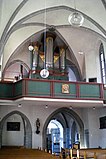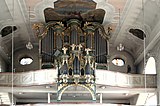Johann Jakob Dahm
Johann Jakob Dahm (* 1659 in Weibern near Kempenich ; † July 10, 1727 in Mainz ) was a German organ builder .
Life
Dahm was born in Weibern in 1659 and baptized in St. Philippus and Jakobus (Kempenich) . As a journeyman he moved to Würzburg around 1680, where he married Maria Barbara Prexendörffer from Würzburg on June 2, 1682 († August 15, 1731 in Mainz). He received citizenship in 1688. During his time in Würzburg, the couple had two daughters and four sons between 1683 and 1696. Dahm had been a citizen of Mainz since May 12, 1698 and was accepted into the goldsmith's guild, from 1705 his title " Domkapitelscher organ maker" can be proven. In addition to Dahm, Lothar Franz von Schönborn also moved the Franconian organ builder Anton Ignaz Will to the Mainzer Hof, who presumably divided their field of work among themselves. Another daughter of Dahm was baptized in Mainz in 1699. Balthasar König and Joseph Gabler were among his students . He died in Mainz in 1727.
plant
Dahm is one of the most important organ builders in the Middle Rhine area at the beginning of the 18th century. In addition to numerous single-manual organs, he also created some larger works, such as for the Mainz Cathedral and Eberbach Monastery , which spread his fame widely. Two-manual works have a return positive , three- manual works have an echo movement. The brochures are from Main Franconia and the dispositions are already influenced by the Middle Rhine. Dahm organs regularly feature French-influenced reeds and the French Cornet in the treble register . The principal choir is fully developed, which is supplemented in color by flute and string parts, especially in the eight-foot position. The sound crowns are designed to be homophonic. The pedal has only a small range of keys. Wooden prospect pipes covered with tin foil can stand in the harp-shaped side panels.
List of works
| year | place | church | image | Manuals | register | Remarks |
|---|---|---|---|---|---|---|
| 1695 | Hopferstadt | St. Peter and Paul | not received | |||
| 1700 | Mainz | St. Sebastian | Attribution; not received | |||
| 1702 | Mainz | Dom | III / P | 34 | In addition to the late Gothic organ on the north wall of the nave, there was another organ on the north choir, which was named "Cüntzer'sche organ" after the founder. Dahm is believed to be the builder of this organ, as no other organ builder was active in the city at that time. The three-manual organ is divided into main work, upper positive, echo and pedal. After being relocated to Hochheim during the French occupation in 1793, the organ was later rebuilt by Ripple. It was not finally canceled until 1928. Some parts of the case have been preserved, which were shown to the public again for the first time during an exhibition in the Mainz Cathedral Museum . | |
| 1704 | Monreal | Trinity Church | I / P | 12 | received changed | |
| 1705 | Mainz | St. Jacob Monastery | Attribution; not received | |||
| 1706 | Rauenthal (Rheingau) | Tiefenthal Abbey | I / P | 10 | not received | |
| around 1707 | Mainz | Liebfrauenstift | Attribution; not received | |||
| 1709 | Eltville on the Rhine | Eberbach Monastery | III / P | 35 | After secularization of the monastery, transferred to the former Mauritius Church in Wiesbaden ; destroyed there in a church fire in 1850 | |
| 1709 | Rudesheim am Rhein | Marienhausen Monastery | not received | |||
| 1710 | Frankfurt am Main | Carmelite Monastery | II / P | 22nd | 1748 expansion by Johann Christian Köhler to include an echo work; 1809 after secularization of the monastery, sale to Flörsheim am Main , St. Gallus Church (photo); This organ was described in a report from 1817 as the best and most beautiful organ in the Duchy of Hesse-Nassau, next to the organ in Eberbach Monastery, which was still in existence at the time and was also built by Dahm; today III / P / 39; Case and 11 registers from Dahm received | |
| 1711 | Weilburg | Castle Church |

|
II / P | 23 | Housing and the (since 1903 mute) prospect pipes from Hauptwerk (Principal 8 ′), Rückpositiv (Principal 4 ′) preserved |
| 1711 | Dietkirchen | Lubentius pen |

|
I / P | 13 | Later rebuilt and expanded several times; In addition to the Dahm case, parts of the pipework have been preserved |
| 1715 | Mainz-Mombach | old St. Nicholas before 1955 | I / p | 8th | Type of a single-manual small church organ in Kurmainz tradition on the basis of a Principal 4 ′. Replaced in 1926 by the new Stahlhut building. | |
| before 1718 | Strinz-Margarethä | Weißfrauenkloster Mainz |

|
I / P | 13 | 1803 sold to the Saalkirche in Nieder-Ingelheim ; considerable damage in the revolutionary war; In 1853 sold to the Protestant Church of Strinz-Margarethä (picture), the decorations and the crowning Madonna remained in Ingelheim; Organ largely preserved |
| before 1718 | Mainz | Dalheim Monastery | Attribution | |||
| 1720 | Mainz | Agnes Monastery | Attribution; Received in Mainz-Gonsenheim until 1904 | |||
| 1721 | Mainz | St. Emmeran | Attribution; Replaced in 1902 by a new building by Martin Joseph Schlimbach | |||
| 1721 | Mainz | Poor Clare Monastery of St. Clare | Attribution; not received |
literature
- Hermann Fischer , Franz Bösken : Dahm, Johann Jakob . In: Music in the past and present . 2nd Edition. Person part, band 5 . Bärenreiter / Metzler, Kassel / Stuttgart 2000, Sp. 268 f .
Web links
- Hermann Fischer: Music and Musicians on the Middle Rhine 2
- Dahm, Johann Jacob. Hessian biography. (As of January 15, 2020). In: Landesgeschichtliches Informationssystem Hessen (LAGIS).
- Entry on Johann Jakob Dahm in the Rhineland-Palatinate personal database
Individual evidence
- ^ A b Hermann Fischer and Franz Bösken: Dahm, Johann Jakob . In: Music in the past and present . 2nd Edition. Person part, band 5 . Bärenreiter / Metzler, Kassel / Stuttgart 2000, Sp. 268 f.
- ^ A b Hermann Fischer: Music and Musicians on the Middle Rhine 2 .
- ↑ Festschrift Orgel Ober-Saulheim , p. 14; accessed on February 17, 2020.
- ^ Franz Bösken: Sources and research on the organ history of the Middle Rhine (= contributions to the Middle Rhine music history . Volume 7.1 ). tape 2 : The area of the former administrative district of Wiesbaden. Part 1: A-K . Schott, Mainz 1975, ISBN 3-7957-1307-2 , p. 146-148 . Franz Bösken: Sources and research on the organ history of the Middle Rhine (= contributions to the Middle Rhine music history . Volume 7.2 ). tape 2 : The area of the former administrative district of Wiesbaden. Part 2: L-Z . Schott, Mainz 1975, ISBN 3-7957-1370-6 , p. 878-882 .
- ^ Organ in Flörsheim. Retrieved February 17, 2020 .
- ^ Franz Bösken: Sources and research on the organ history of the Middle Rhine (= contributions to the Middle Rhine music history . Volume 7.1 ). tape 2 : The area of the former administrative district of Wiesbaden. Part 1: A-K . Schott, Mainz 1975, ISBN 3-7957-1307-2 , p. 188-196, 272-277 .
- ^ Franz Bösken: Sources and research on the organ history of the Middle Rhine (= contributions to the Middle Rhine music history . Volume 7.2 ). tape 2 : The area of the former administrative district of Wiesbaden. Part 2: L-Z . Schott, Mainz 1975, ISBN 3-7957-1370-6 , p. 802-806 .
- ^ Franz Bösken: Sources and research on the organ history of the Middle Rhine (= contributions to the Middle Rhine music history . Volume 7.1 ). tape 2 : The area of the former administrative district of Wiesbaden. Part 1: A-K . Schott, Mainz 1975, ISBN 3-7957-1307-2 , p. 121-124 .
| personal data | |
|---|---|
| SURNAME | Dahm, Johann Jakob |
| BRIEF DESCRIPTION | German organ builder |
| DATE OF BIRTH | 1659 |
| PLACE OF BIRTH | Women |
| DATE OF DEATH | July 10, 1727 |
| Place of death | Mainz |

